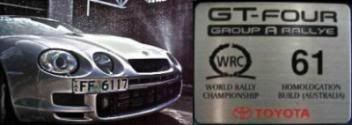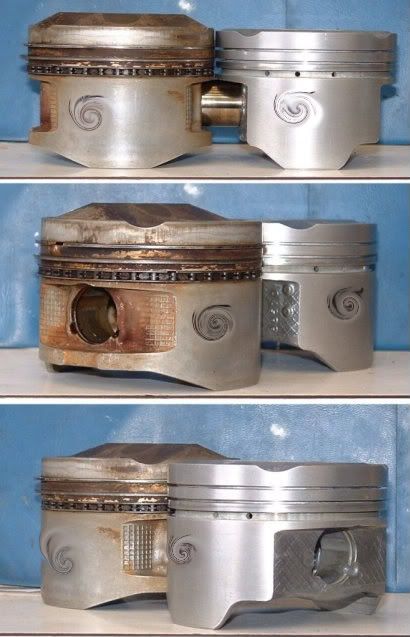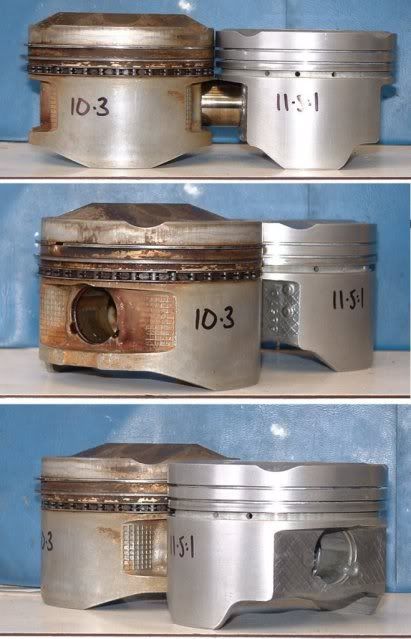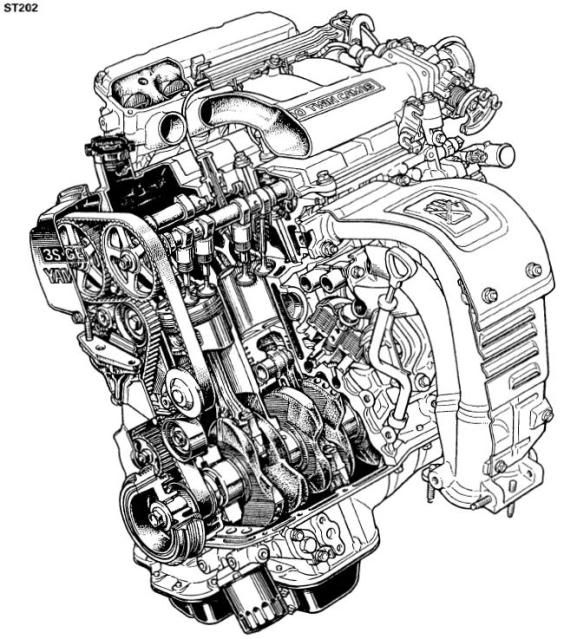  |
 Sep 13, 2008 - 11:05 PM Sep 13, 2008 - 11:05 PM
|
|
 Enthusiast      Joined Feb 11, '08 From Auckland, New Zealand Currently Offline Reputation: 0 (0%) |
thats alright QUOTE how would i go about modding my ACIS? rather than tell you how to mod it heres a way how not to mod it http://toymods.net/forums/showthread.php?t...;highlight=ACIS (also I recommend a new thread for 3SGE ACIS/Beams discussion) I've been playing around with ACIS recently and I've discovered a few things about it, The basics ... when the vacuum diaphragm pulls the throttles, the larger diameter in the corner of the inlet pipes open up (under the lid) for high rpm and when there is no vacuum to pull the throttles are free to return to the constricted low rpm position. A few problems noted with ACIS: 1. When switching between high and low rpm modes, the vacuum diaphragm sometimes get stuck in the high rpm mode 2. The engage point is too late First experiment was to see how the car behaved with the throttle pull lever tied up with cable ties as to lock the throttles in the high rpm position, What I observed with the butt dyno was that under full throttle the rpm range where the car would "suddenly get up and go" was lower down, noticed in terms of road speed 65kph before, 55kph after (2nd gear) so in other words 5000-7000 was the get up and go range, without ACIS constriction in the intake the get up and go range was observed from 4000 to 7000. No loss in acceleration was noticed from idle to 3000 under part throttle, but loss was noticed under full throttle, between 3000 and 4000 I couldn't tell either way in neither part throttle nor full throttle whether ACIS was better in low rpm or high rpm mode.... This suggests to me that 4000 is a better changeover point than 4800 for performance. 4800 is an rpm not reached by normal driving due to speed limits & gear selection thus ACIS seems to exist for the purpose of keeping intake noise down at legal road speeds rather than for improving low rpm torque as midrange torque takes a hit with this setup. My proposed solution on how TO mod the ACIS, is to gutt the vacuum actuator system and replace it with a motorised cable pulling actuator triggered by a frequency switch relay at 4000 rpm the signal could be obtained by the ignitor right behind there. -------------------- Mike W
1996 Toyota Celica ST205 GT-FOUR GT2860RS turbine, TiAL mvr44, JE 86.5φ piston, Clutchmasters FX400, APEX P-FC 269awhp / 273ft-lbs |
 Sep 14, 2008 - 12:57 AM Sep 14, 2008 - 12:57 AM
|
|
 Moderator      Joined Nov 5, '07 From New Zealand Currently Offline Reputation: 3 (100%) |
ha sweet finally started a thread, I'd thought I'd start with some Information. This is theory of ACIS
QUOTE (Wikipedia) Acoustic Control Induction System, or ACIS, is an implementation of a Variable Length Intake Manifold system designed by Toyota. Simply put, the ACIS system uses a single intake air control valve located in the intake to vary the length of the intake tract in order to optimize power and torque, as well as provide better fuel efficiency and reduce intake "roar".[1]. The ECU controls the position of the intake air control valve based on input signals from throttle angle and engine RPM. The vacuum switching valve (VSV) which controls the vacuum supply to the actuator is normally closed and passes vacuum to the actuator when it is energized by the ECU. By energizing the VSV vacuum is passed to the actuator, closing the air control valve. This effectively lengthens the intake manifold run. By de-energizing the VSV, vacuum to the actuator is blocked and trapped vacuum is bled off of the actuator diaphragm. Without vacuum, the air control valve opens, effectively shortening intake runner length[1]. This logic is the same as that used on the T-VIS system, the primary difference being that T-VIS actuates at a set RPM value whereas ACIS attempts to maintain a constant powerband by opening progressively.    Anyone who says that ACIS uses compression is WRONG or says it has a form of VVT is WRONG QUOTE Toyota Variable Induction System, or T-VIS, is a variable intake system designed by Toyota. It improves the low-end torque of high-performance, small displacement four-stroke engines by changing the geometry of the intake manifold according to the engine rotation speed. The system uses two separate intake runners per cylinder, one being equipped with a butterfly valve that can either open or close the runner. All valves are attached to a common shaft which is rotated by a vacuum actuator outside the manifold. The engine control unit allows vacuum into the actuator by powering a solenoid valve when the engine rotation speed is below 4200 rpm.Above this engine speed vacuum is cut off and a spring inside the actuator causes the butterfly valve to fully open. The theory behind the system is that in the lower speed band the velocity of the intake air can be improved because the intake runner cross section per cylinder is smaller. However, when the engine gains speed, the required air flow volume is more significant so the second runner is opened to improve the flow. With upgraded engines (more flow) you may want to have your T-VIS open earlier than stock because it begins to choke the airflow at a lower RPM, since the airflow per RPM is greater with upgraded turbos, intakes, and exhaust. There is now a T-VIS controller on the marketT-VIS controller. QUOTE VVT-i, or Variable Valve Timing with intelligence, is an automobile variable valve timing technology developed by Toyota, similar to the i-VTEC technology by Honda. The Toyota VVT-i system replaces the Toyota VVT offered starting in 1991 on the 4A-GE 20-Valve engine. The VVT system is a 2-stage hydraulically controlled cam phasing system. VVT-i, introduced in 1996, varies the timing of the intake valves by adjusting the relationship between the camshaft drive (belt, scissor-gear or chain) and intake camshaft. Engine oil pressure is applied to an actuator to adjust the camshaft position. In 1998, "Dual" VVT-i (adjusts both intake and exhaust camshafts) was first introduced in the RS200 Altezza's 3S-GE engine. Dual VVT-i is also found in Toyota's new generation V6 engine, the 3.5L 2GR-FE V6. This engine can be found in the Avalon, RAV4, and Camry in the US, the Aurion in Australia, and various models in Japan, including the Celica. Dual VVT-i is also used in the Toyota Corolla (1.6 dual VVT-i 124bhp). Other Dual VVT-i engines include the 1.8L 2ZR-FE I4, used in Toyota's next generation of compact vehicles such as the Scion XD. It is also used in the 2JZ-GE and 2JZ-GTE engines used in the Lexus IS300 and in the Toyota Supra. By adjusting the valve timing engine start and stop occurs virtually unnoticeably at minimum compression. In addition fast heating of the catalytic converter to its light-off temperature is possible thereby reducing hydrocarbon emissions considerably. VVT-i Video  QUOTE In 1998, Toyota started offering a new technology, VVTL-i, which can alter valve lift (and duration) as well as valve timing. In the case of the 16 valve 2ZZ-GE, the engine has 2 camshafts, one operating intake valves and one operating exhaust valves. Each camshaft has two lobes per cylinder, one low rpm lobe and one high rpm, high lift, long duration lobe. Each cylinder has two intake valves and two exhaust valves. Each set of two valves are controlled by one rocker arm, which is operated by the camshaft. Each rocker arm has a slipper follower mounted to the rocker arm with a spring, allowing the slipper follower to move up and down with the high lobe without affecting the rocker arm. When the engine is operating below 6000 rpm, the low lobe is operating the rocker arm and thus the valves. When the engine is operating above 6000 rpm, the ECU activates an oil pressure switch which pushes a sliding pin under the slipper follower on each rocker arm. This in effect, switches to the high lobe causing high lift and longer duration.
Toyota has now ceased production of its VVTL-i engines for most markets, because the engine does not meet Euro IV specifications for emissions. As a result, some Toyota models have been discontinued... Celica -------------------- |
 Sep 14, 2008 - 6:38 AM Sep 14, 2008 - 6:38 AM
|
|
 Enthusiast      Joined Feb 11, '08 From Auckland, New Zealand Currently Offline Reputation: 0 (0%) |
that is good information and makes things alot simpler to mod the ACIS, so instead of mechanically operating the ACIS throttles, I need to locate the vacuum solenoid valve and send my own power signals to it.
as for the claim that it attempts to maintain a constant power band, this is all fine and dandy if it were true, as noticed it gets stuck in the high rpm position alot even when coming to a complete stop and then starting again, flooring the pedal from a low speed in 2nd gear and listening to the full rpm range. Sometimes the vacuum will be pulling the acis throttles when the motor starts, looking in the engine bay, turn off the motor and turn it on again and it will be back in the low rpm position... these characteristics are surely not as intended, possibly due to having a different air filter setup, either way I'd say 4000 makes a better point to engage the short path. the 2nd big power surge is still equally noticed as before at around 80kph in 2nd gear whether the short path is forced or not. -------------------- Mike W
1996 Toyota Celica ST205 GT-FOUR GT2860RS turbine, TiAL mvr44, JE 86.5φ piston, Clutchmasters FX400, APEX P-FC 269awhp / 273ft-lbs |
 Sep 14, 2008 - 9:08 AM Sep 14, 2008 - 9:08 AM
|
|
|
Moderator      Joined Oct 1, '02 From fall river, ma Currently Offline Reputation: 13 (100%) |
IMO the best way to find the "switching" point would be much like the 3sgte guys do the tvis opening thing.
back to back dyno runs, one with it open, one with it closed. the point where the 2 runs overlap is the ideal switching point. thread moved. -------------------- Former Team 5SFTE pro member ;)
 13.6@108MPH, 5SFTE Powered |
 Sep 19, 2008 - 1:28 AM Sep 19, 2008 - 1:28 AM
|
|
 Moderator      Joined Nov 5, '07 From New Zealand Currently Offline Reputation: 3 (100%) |
ah here's the information I was thinking of previously: http://www.turbomr2.com/MR2/Reference/TVIS/TVIS.htm
191.23 Nm / 4800 rpm (almost 100Nm a litre) & the switch over is 5100rpm or 5200rpm, also I'm not 100% sure about this but during the switch over it advances timing, by a ECM (electric control module) or ECU?, I like your idea about taking 2 dyno runs (open and closed) and finally (thanks to the guys from CelicaTech) The Ultimate 3S-GE Tuning Guide This post has been edited by Rusty: Jun 24, 2009 - 12:52 AM -------------------- |
 Sep 29, 2008 - 6:39 AM Sep 29, 2008 - 6:39 AM
|
|
 Enthusiast      Joined Feb 11, '08 From Auckland, New Zealand Currently Offline Reputation: 0 (0%) |
ACIS Modification project
------------------------------- Parts required: A spare vacuum solenoid valve, some length of automotive wire, and this Jaycar kit (Frequency Relay Switch) ---  Soooooo.... The standard engage point for ACIS is roughly 4800 RPM, the point where it goes niiiiiiiiiiiiiiiiiiiiiiiiiBWARRRRRRRRRRRRRRRRRRRR, in 2nd gear and the tachometer lunges past the 5k mark (65kph) and the car gains speed as though the pedal wasnt floored before but now it is.... Now that my custom ACIS RPM-adjustable controller project is complete, I set out to test it out at a tiny bit over 4k... And the results are amazing.... the same speed jump at the 5k mark is observed at the 4k mark (52kph).......... I've recorded a video which I think demonstrates this (not dyno proof, but judge for yourself)... Sorry about the first 30 seconds of engine braking, the rest of it is a motorway run testing out the 4k engage point with 2nd and 4th gears.... 2nd gear 4k is 55kph, 4th gear 4k is 110kph  notice the speed jumps at .... (with the video timer counting down) -00:45s. -00:27s, -00:17s This post has been edited by delusionz: Sep 29, 2008 - 6:40 AM -------------------- Mike W
1996 Toyota Celica ST205 GT-FOUR GT2860RS turbine, TiAL mvr44, JE 86.5φ piston, Clutchmasters FX400, APEX P-FC 269awhp / 273ft-lbs |
 Sep 29, 2008 - 8:25 PM Sep 29, 2008 - 8:25 PM
|
|
 Enthusiast    Joined Dec 15, '02 From Tasmania(Australia) Currently Offline Reputation: 0 (0%) |
i say try another vid but go in a straight line, the 45 sec one you can hear a change but not see it because the camera is looking at the fuel guage.
and start from say 3 grand in 3rd, then let it rev right out to 6 grand or so, so we get a good idea how fast the needle was moving before acis (just kicked in yo edit: did see the speed jump, but i say go again, and in straight line. This post has been edited by Cuts_the_Pilot: Sep 29, 2008 - 8:27 PM -------------------- ST205 Group A Rallye GT-Four, #61 of 77............600hp GT3582r
GRX133 Toyota Mark X 350s  |
 Sep 29, 2008 - 11:00 PM Sep 29, 2008 - 11:00 PM
|
|
 Moderator      Joined Nov 5, '07 From New Zealand Currently Offline Reputation: 3 (100%) |
QUOTE i say try another vid but go in a straight line, the 45 sec one you can hear a change but not see it because the camera is looking at the fuel guage. ...lol not being mean or anything, but that sound quite funny.looks really impressive and sounds even better, but your not using foot-tech aswell are you? and I say go for a dyno for asap, because I'd expect to see a big gain where i see a dip in the power curve (which I thing is about 5,000rpm anyway) -------------------- |
 Sep 30, 2008 - 2:41 AM Sep 30, 2008 - 2:41 AM
|
|
 Enthusiast      Joined Feb 11, '08 From Auckland, New Zealand Currently Offline Reputation: 0 (0%) |
yeah, i had the pedal pressed as hard as i could around the changeover, I tried again with 3800 RPM engage point and between 4k and 4.5k it became slow and sounded ****... sounded like low rpm flooring, I managed to fine tune it today (stupid tiny potentiometers) to 4300 RPM and its even better, also changed that hideous light bulb for a discreet blue led, it might become permanent actually...
I'm pretty keen for a before and after dyno, how much did yours cost rusty? -------------------- Mike W
1996 Toyota Celica ST205 GT-FOUR GT2860RS turbine, TiAL mvr44, JE 86.5φ piston, Clutchmasters FX400, APEX P-FC 269awhp / 273ft-lbs |
 Sep 30, 2008 - 2:51 AM Sep 30, 2008 - 2:51 AM
|
|
 Enthusiast    Joined Jan 13, '08 From Christchurch New Zealand Currently Offline Reputation: 0 (0%) |
I am real interested in seeing two dyno runs with your set up.
If it works you should post up your full set up so people like me can copy --------------------  1994年 トヨタ 神々しい My Facebook My Bebo QUOTE (loll6g @ Nov 6, 2008 - 5:53 AM) automatics are for lazy ass drivers who jst want there car so that they can look cool |
 Oct 1, 2008 - 12:28 AM Oct 1, 2008 - 12:28 AM
|
|
 Moderator      Joined Nov 5, '07 From New Zealand Currently Offline Reputation: 3 (100%) |
well I got mine done at lodge auto for $60 but we entered as a group and got a slight discount
-------------------- |
 Oct 1, 2008 - 5:14 AM Oct 1, 2008 - 5:14 AM
|
|
 Enthusiast      Joined Feb 11, '08 From Auckland, New Zealand Currently Offline Reputation: 0 (0%) |
Hmmm 4300 is very smooth to changeover, no jump in speed, I got it right on the 4000 mark now and it kicks in yo
This project still needs some more work though, especially with the vacuum routing, The throttles are flicking open and then closed and then is subject to the factory VSV's opening and closing as I've simply spliced into the standard setup (the main reason for doing so was to force the throttles closed at low rpm as they seemed happy to stay open from idle giving me occasional sluggish low rpm acceleration), Perhaps unplugging from the standard VSV and rejoining with a hose coupling would smooth out the irateness of my ECU without it erroring. I also need to splice onto a permanent RPM signal place, I'm just plugged into the diagnostic box at the moment, I'm sure the dyno guys will want to use the diagnostic plug... -------------------- Mike W
1996 Toyota Celica ST205 GT-FOUR GT2860RS turbine, TiAL mvr44, JE 86.5φ piston, Clutchmasters FX400, APEX P-FC 269awhp / 273ft-lbs |
 Jun 8, 2009 - 3:41 AM Jun 8, 2009 - 3:41 AM
|
|
 Moderator      Joined Nov 5, '07 From New Zealand Currently Offline Reputation: 3 (100%) |
Right there has been some recent discussion lately about the 3S-GE so I thought I'd do my bit and best inform people with what information I know.
I've already stated this in another topic but I'll add it here now anyway QUOTE Camshaft Sizes 2. Gen 3S-GE In: 244deg, 8.5mm lift (timing 7/57) Valve diameter: 33.5mm Ex: 244deg, 8.5mm lift (timing 57/7) Valve diameter: 29.0mm 2. Gen 3S-GTE In: 236deg, 8.2mm lift (timing 8/ ) Valve diameter: 33.5mm Ex: 236deg, 8.2mm lift (timing 56/0) Valve diameter 29.0mm 3. Gen 3S-GE A/T In: 240deg, 8.7mm lift (timing 7/53) Valve diameter: 33.5mm Ex: 240deg, 8.2mm lift (timing 53/7) Valve diameter: 29.0mm 3. Gen 3S-GE M/T In: 252deg, 9.8mm lift (timing 7/65) Valve diameter: 33.5mm Ex: 240deg, 8.2mm lift (timing 53/7) Valve diameter: 29.0mm 3 Gen 3S-GTE In: 240deg, 8.7mm lift (timing 7/53) Valve diameter: 33.5mm Ex: 236deg, 8.2mm lift (timing 50/6) Valve diameter: 29.0mm 4 Gen BEAMS Redtop 3S-GE IN: 256deg, 10.5mm lift (timing /) Valve diameter: 34.5mm EX: 244deg, 9.2mm lift (timing /) Valve diameter: 29.5mm 4 Gen 3S-GTE IN: deg, .mm lift (timing /) Valve diameter: .mm EX: deg, .mm lift (timing /) Valve diameter: .mm **please note no newer gen camshaft are interchangeable with gen 1 3S engines (ie gen1 with gen3 cams = no. however gen1 3sgte with gen1 3sge = yes) QUOTE Compression 2 Gen 3SGTE 8.8:1 3 Gen 3SGE A/T 10.3:1 3 Gen 3SGE M/T 10.3:1 3 Gen 3SGTE M/T 8.5:1 4 Gen (RED BEAMS) 3SGE A/T 11:1 4 Gen (RED BEAMS) 3SGE M/T 11:1 now 3.gen 3sge uses MAP while the 4.genR 3SGE uses MAF this thread has some good info relating to that. that'll do for now more tomorrow **please note all figures above are based on Japanese celica models** here's something to think over, which piston is which gen 3S-GE? 
This post has been edited by Rusty: Dec 3, 2010 - 5:48 PM -------------------- |
 Jun 8, 2009 - 10:06 AM Jun 8, 2009 - 10:06 AM
|
|
|
Enthusiast     Joined Jun 25, '06 From Box Elder, South Dakota Currently Offline Reputation: 2 (100%) |
I love games!! I take it the clean piston is from a 3rd gen. Dirty one is from the 4th gen...
-------------------- (\__/)
(='.'=) This is bunny. Copy and paste bunny into your (")_(") signature to help him gain world domination. |
 Jun 8, 2009 - 10:27 AM Jun 8, 2009 - 10:27 AM
|
|
|
Enthusiast      Joined Dec 19, '07 From tx Currently Offline Reputation: 22 (100%) |
My guess is the dometop ones on the left are BEAMs pistons due to the increased compression
--------------------  ENGINE: '93 RC 3S-GTE/WRC CT-20b [18-20PSI] PERF: TRD/HKS/ARP/NGK/MSD/ACT/Blitz/STRI/APEX'i/TwosRus/GReddy/Magnaflo/KOYO SUSP: Tein/Bilstein/SusTech/ INT: SS-III SEATS/Toyota Hyper Sports EXT: WRC/TRD/404 Its a safety feature so that people like you don't end up killing themselves or everyone around them. Slow down Paul Walker. 6GC Chat - Go there: [url="http://www.griffgirl.com/forum/chat/index.php[/url] |
 Jun 8, 2009 - 12:27 PM Jun 8, 2009 - 12:27 PM
|
|
 Moderator      Joined Nov 5, '07 From New Zealand Currently Offline Reputation: 3 (100%) |

-------------------- |
 Jun 8, 2009 - 1:27 PM Jun 8, 2009 - 1:27 PM
|
|
|
Enthusiast      Joined Dec 19, '07 From tx Currently Offline Reputation: 22 (100%) |
LOL - If you call THOSE dirty pistons you should see the ones I pulled from my '93 3S-GTE
--------------------  ENGINE: '93 RC 3S-GTE/WRC CT-20b [18-20PSI] PERF: TRD/HKS/ARP/NGK/MSD/ACT/Blitz/STRI/APEX'i/TwosRus/GReddy/Magnaflo/KOYO SUSP: Tein/Bilstein/SusTech/ INT: SS-III SEATS/Toyota Hyper Sports EXT: WRC/TRD/404 Its a safety feature so that people like you don't end up killing themselves or everyone around them. Slow down Paul Walker. 6GC Chat - Go there: [url="http://www.griffgirl.com/forum/chat/index.php[/url] |
 Jun 9, 2009 - 2:01 AM Jun 9, 2009 - 2:01 AM
|
|
 Moderator      Joined Nov 5, '07 From New Zealand Currently Offline Reputation: 3 (100%) |
something form wiki
QUOTE These are common to all 3S-G engines. Capacity 1,998 cc (121.93 cu in) Bore x Stroke 86 mm (3.39 in) x 86 mm (3.39 in) Intake Valve Diameter 33.5 mm (1.32 in) Exhaust Valve Diameter 29.0 mm (1.14 in) Included Valve Angle 44.5 ° right onto the info for 3gen and 4gen 3S-GE engines The Sump QUOTE Gen3 The sump is 2 pieces, with a large alloy part bolted to the block & a very small pressed steel piece below it. Gen4 Same as Gen 3. Oil Filter Location QUOTE Gen3 The oil filter is down on the alloy intermediate sump. Gen4 Same as Gen 3. Cyclinder Head QUOTE Gen3 The cylinder head has the valve clearance shims under the bucket. Gen4 The cylinder head is Gen 3 type but has variable cam timing on the inlet only. The cam cover is red & has the word “beams” in silver script.  -------------------- |
 Jun 9, 2009 - 11:59 AM Jun 9, 2009 - 11:59 AM
|
|
|
Enthusiast      Joined Apr 24, '08 From Orange County, CA Currently Offline Reputation: 33 (100%) |
so it sounds as if most of internals from 3rd and 4th gen 3sge are the same. Is the vvti what adds ahd 20 hp difference between the motors???
-------------------- Group buy to replicate Narrow E series transaxle parts
http://www.6gc.net/forums/index.php?showto...p;#entry1107514 |
 Jun 9, 2009 - 12:45 PM Jun 9, 2009 - 12:45 PM
|
|
 Moderator      Joined Nov 5, '07 From New Zealand Currently Offline Reputation: 3 (100%) |
its also the increase in compression (from 10.3 to 11) and the ECU, I would think
-------------------- |
  |
11 User(s) are reading this topic (11 Guests and 0 Anonymous Users)
0 Members:
| Lo-Fi Version | Time is now: November 16th, 2024 - 4:55 PM |




